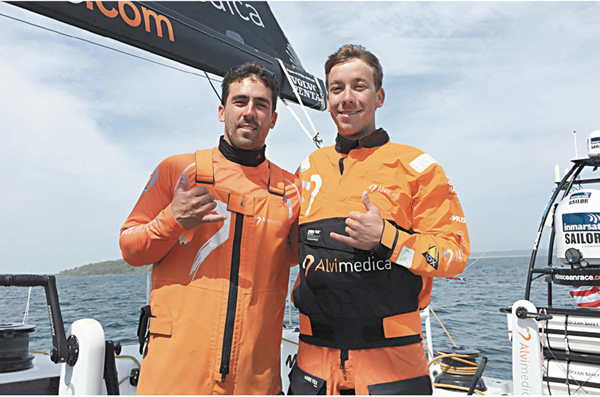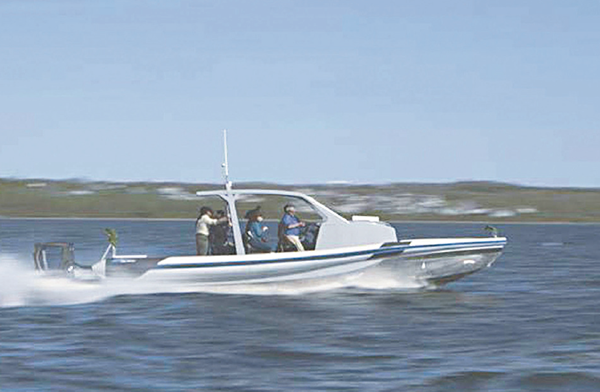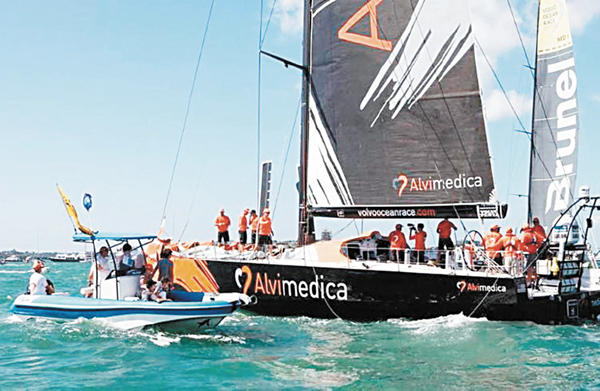Calming Waters At Volvo Ocean Race

Mark (left) and Ian Towill with Team Alvimedica PHOTO COURTESY IAN TOWILL
Hawaii is making waves at this year’s Volvo Ocean Race series, but in a very calming way.
Navatek’s new Sea Blade TM 22 rigid hull inflatable boat is providing water support for Team Alvimedica in the Volvo Ocean Race’s only North American stopover, Newport, R.I.
“We thought it would be a great debut for us out on the East Coast,” says Steven Loui, architect of Navatek and president of Pacific Marine & Supply Co. “We saw it as a wonderful opportunity for a different audience to see our Hawaii born product, and we believe it was a great coming out party!”
In addition to Sea Blade’s important role, Hawaii’s ties include Punahou graduate Mark Towill, who is sailing with Team Alvimedica and is the team’s general manager.
Navatek engineer Ian Towill surprised his older brother Mark when he greeted Team Alvimedica offshore, along with parents Crystal Rose and Rick Towill.
“We’ve been following Mark’s career for many years, and we know his parents Rick and Crystal very well,” says Loui, who appeared on MidWeek’s cover Oct. 22, 2013, when the Sea Blade first was unveiled. “His younger brother Ian works with us, so we thought it was a great opportunity for us to launch the boat on the East Coast while supporting one of our own.”
This wasn’t the Sea Blade’s first appearance with Team Alvimedica. The vessel’s orig- inal debut with the team was during the Auckland, New Zealand, Volvo Ocean Race.
In partnership with Navatek, New England Boatworks (NEB) will provide logistical support on the SB22 and will use it to promote its construction of Navatek’s 35-foot highspeed yacht tender, the Sea Blade 35, launched last week in time to support the Volvo inshore races as an umpire boat.

Sea Blade on the move PHOTOS COURTESY NEW ENGLAND BOATWORKS
The Sea Blade had been a vision of Loui’s for many years. He officially launched the project in 2005 with the goal of re-engineering rough- sea hull design that some say had not seen changes or improvements since its invention more than 50 years ago.
After seven years, numerous military vessel prototypes, 28 patents and inventions, and countless hours in Hawaiian waters, the Sea Blade was born.
Loui says he and others quickly realized that the Sea Blade is perfectly suited to escort sailboats in ocean races. He says the boat’s design makes for soft re-entry land- ings, and reduces slamming, pounding and plunging in ocean conditions greater than
4 feet.
“The sailing boats are moving so swiftly now, and they’re doing so with a lot of wind and a lot of chop,” says Loui. “In the Volvo, people are seeing that the Sea Blade is a real good ride in rough water. It’s been well received because we can keep up with them and serve as superior rescue, patrol and support boats. The crew is loving it.”

Sea Blade in rough conditions at the Volvo Ocean Race
The Sea Blade’s presence at the Volvo Ocean Race is more confirmation that 52 years of lessons learned was worth it.
Loui says his late father Fred, founder of Pacific Marine & Supply, and the man credited with building the first fiberglass boats in Hawaii between 1958 and 1962, would be proud of the Sea Blade’s Volvo Ocean Race appearance.
“I think he’d be really proud,” says Loui. “We always feel like, when it comes to Hawaii, we’re not second best to anybody, whether it’s Hokule‘a or medical research. We’re big supporters of ‘made in Hawaii.’ It’s a great moment that our Hawaii design is being well-received elsewhere. We couldn’t be more pleased and
more proud.”
A calming thought in what can be turbulent conditions





